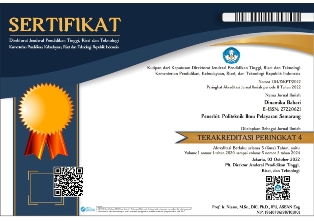Dwelling Time pada Sistem dan Prosedur Penanganan Peti Kemas dengan Aplikasi Cost Terminal Operation System di Terminal Peti Kemas Semarang
Abstract
The performance system at the container terminal at Semarang Container Terminal (SCT) is not yet good, it can be seen from the average dwelling time which is still long. Dwelling time optimization needs to be done in order to get a balance of projected increases during trading and to compensate for the various limitations of terminal facilities and infrastructure. One of them is the container handling procedure using an application, namely the cost terminal operating system application. With the qualitative descriptive method, the dwelling time and container handling procedures will be explained using a cost terminal operation system application and the quantitative method is used to find out how much use is in the presence of a vehicle terminal using the formula. There is a very significant positive effect of dwelling time on Port revenue. The long dwelling time is due to several factors, such as high volume / import demand which causes queues during the inspection procedure, 24-hour system inability to perform inspection procedures, weather conditions, and importer readiness. By implementing this system there will be an acceleration of the dwelling time so that Beneficial to importers and the impact caused by container dwelling time after using the cost terminal operation system application is that the waiting time can be reduced.
Downloads
References
Adris.A.Putra, & Djalante, S. (2011). Pengembangan Insfratruktur Pelabuhan Dalam Mendukung Pembangunan Berkelanjutan. Ilmiah Media Engineering Vol.6, 6(2), 84–93.
Anita, S. L., & Asmadewa, I. (2017). Analisis Dwelling Time Impor Pada Pelabuhan Tanjung Priok Melalui Penerapan Theory of Constraints. Jurnal Perspektif Bea Dan Cukai, 1(1). https://doi.org/10.31092/jpbc.v1i1.125
Biro Komunikasi dan Informasi Publik. (2018). Empat Puluh Persen Jalur Perdagangan Dunia Melewati Indonesia. Departemen Perhubungan. http://dephub.go.id/post/read/empat-puluh-persen-jalur-perdagangan-dunia-melewati-indonesia
Gultom, E. (2017). Pelabuhan Indonesia sebagai Penyumbang Devisa Negara dalam Perspektif Hukum Bisnis. Kanun : Jurnal Ilmu Hukum, 19(3), 419–444. https://doi.org/10.24815/kanun.v19i3.8593
Patiung, R., Darma, R., & Brasit, N. (2018). Peranan Petikemas Dalam Menunjang Ekspor Impor Komoditi Hasil Pertanian Di Pelabuhan Soekarno Hatta Makassar. Pasca.Unhas.Ac.Id. http://pasca.unhas.ac.id/jurnal/files/01e41d4c73974f84977af0487a43bd3f.pdf
Rafi, S., & Purwanto, B. (2016). Dwelling Time Management (Antara Harapan dan Kenyataan di Indonesia) Salahudin. Jurnal Manajemen Bisnis Transportasi Dan Logistik (JMBTL), 2(2), 220–228.
Santosa, A. B. (2004). Globalisasi dan Perdagangan Internasional.
Saputra, R. (2017). Evaluasi kinerja angkutan peti kemas di terminal peti kemas semarang.
Sasmita, S. (2015). Reformasi Struktur Perdagangan Internasional Dalam Wto: Perspektif Joseph E.Stiglitz. Jurnal Hubungan Internasional, 4(2), 192–203. https://doi.org/10.18196/hi.2015.0079.192-203
Yunianto, I. T., Nur, H. I., Ardhi, E. W., & Adhitya, B. P. (2018). Model Evaluasi Trayek Kapal Tol Laut Untuk Maluku dan Papua Bagian Selatan ( Evaluation Model of Tol Laut Route for Moluccas and Southern Papua ) Irwan Tri Yunianto , Hasan Iqbal Nur , Eka Wahyu Ardhi , Bianca Prima Adhitya Departemen Teknik Transportasi.














